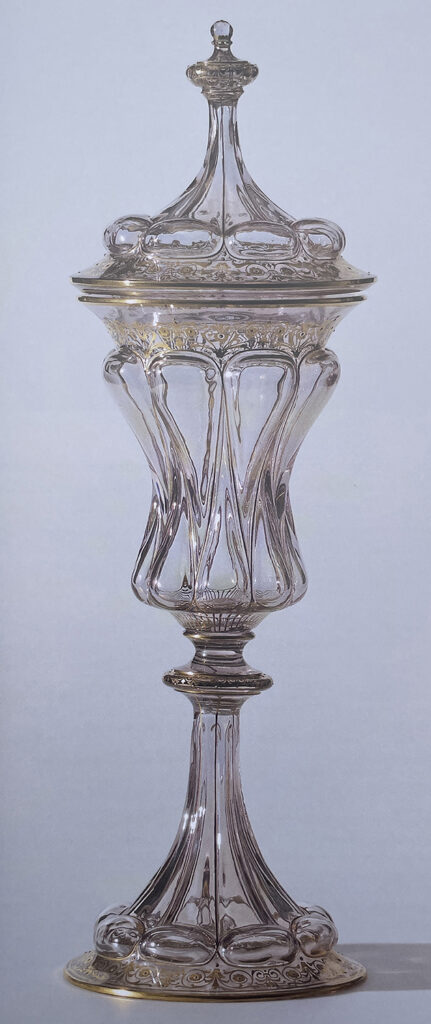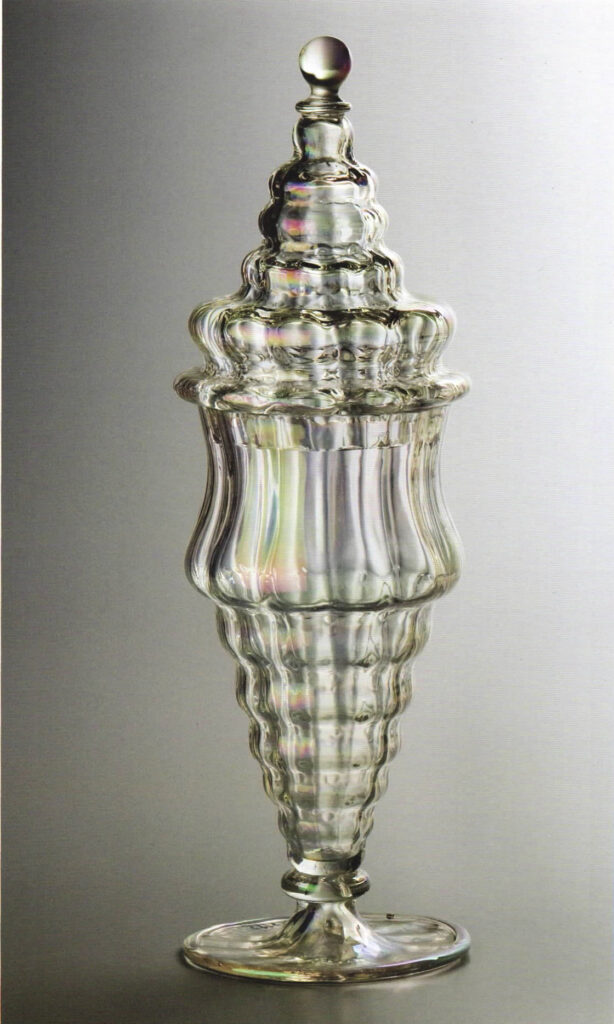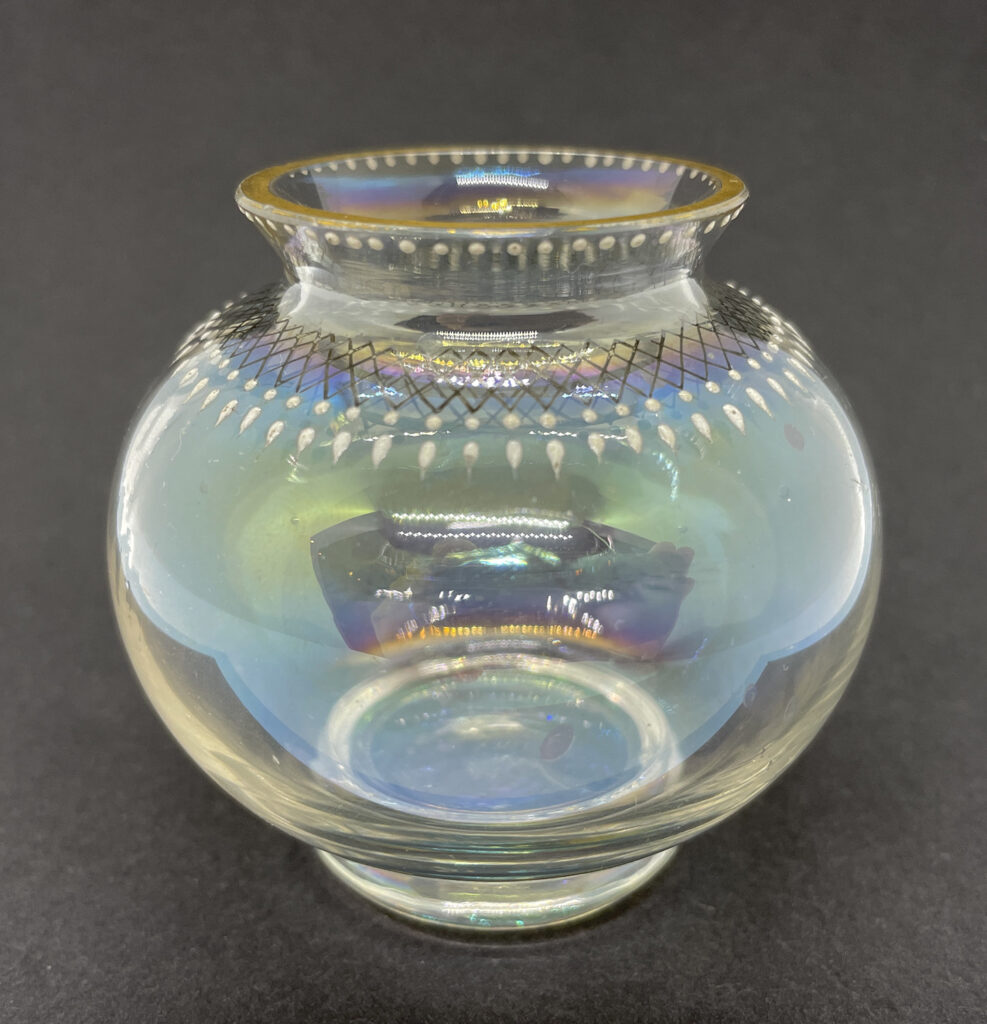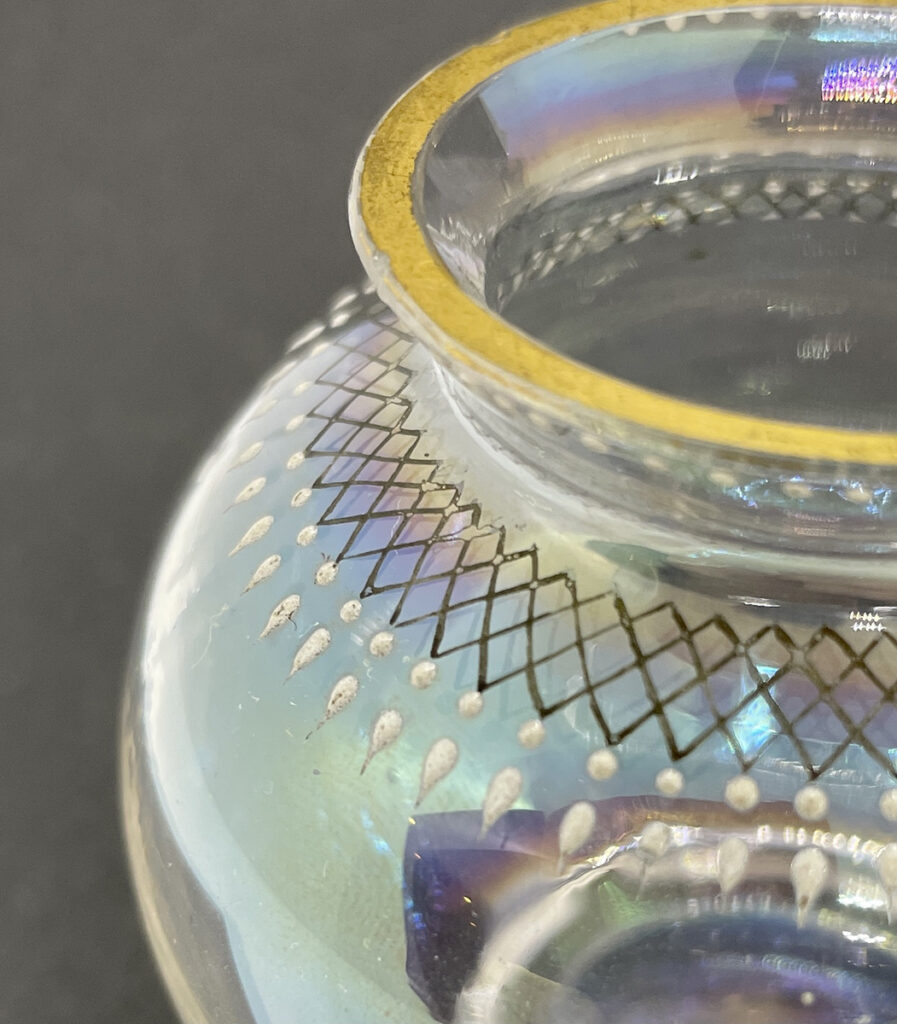In 2013, I wrote a blog post on the origins of iridescent glass. Despite credit usually going to the hugely successful Art Nouveau iridescent glass produced by Tiffany and Loetz from the 1890s onwards, the origins of iridescent glass actually date back to 1856 and a Hungarian chemist and technician called Leo Valentin Pantocek. You can read that post by clicking here. But Pantocek’s name isn’t widely known at all, indicating that he had little or no wider, commercial success. So what happened to iridescent glass in the intervening four decades from its development in 1856 to Tiffany and Loetz in the mid-1890s? Surely someone must have produced a commercially successful range of iridescent glass for sale to the public? This post attempts to answer that question.

The Story So Far (In Brief)…
Pantocek’s iridescent glass was produced by János Zahn’s factory in Zlatno in small quantities from 1856, and a range was exhibited at the 1862 World’s Fair in London. However, despite being lauded, it was largely ignored – except by esteemed and respected Austrian company J&L Lobmeyr. The Lobmeyr brothers saw a future in it, lured a worker away from Zahn’s factory and began to produce it for themselves at one of Wilhelm Kralik’s Meyr’s Neffe factories, probably Adolfshutte. Lobmeyr then exhibited a large range of it at the World’s Fair in Vienna in 1873, to great acclaim. Iridescent glass had arrived.

However, very few examples of the iridescent glass made at Zahn’s or Kralik’s factories have ever been found. The exhibition pieces – which tend to be larger, highly complex ‘show pieces’ like those shown here – tended not to be put into commercial production due to their high costs of production. Lobmeyr is, and always has been, a high end luxury retailer uninterested in the mass market. And, although producing high quality work, Zahn’s factory, which is little known today, almost certainly didn’t have the reach or scaleability to deal with the mass market.
Towards Commercial Production
According to Peter Rath of Lobmeyr, via Mike Moir, Lobmeyr didn’t like to rely on a single factory to supply any particular type of glass to them. In (or before) 1875, Lobmeyr began commissioning glass from the large, well-established firm of Harrach, as evidenced by a Harrach pattern book dated 1875 also bearing the title ‘LOBMEYR’. This was two years after Lobmeyr successfully exhibited their iridescent glass in Vienna. It’s highly likely that Lobmeyr would have passed on the iridescent glass production techniques to Harrach, to both act as a backup for Kralik’s company, and/or to produce new high end ranges for them. It’s also highly likely that the larger scale, highly commercial Harrach would have taken the techniques and run with them, producing their own ranges for sale. Especially given the success of the finish at a World’s Fair only a few years before. Think catwalk to high street.
In his monograph book on Harrach glass (see below), Jan Mergl states that “…the beginning of the production of iridescent glass [at Harrach] is dated to the years 1875-76.” Mergl also states that “…in 1877 – as evidenced by the dating of the records in the company documentation – the glassworks introduced into regular production smaller vases made of Iris Glass with simple painted ornamental patterns…” This humble little ball-shaped posy vase is potentially an example of this earliest “regular production” commercial iridescent range by Harrach.

A late 1870s Harrach iridescent, enamelled and gilded ‘Iris Glass’ ball vase. 6.5cm (2.5in) high 
Detail, showing the enamelled design.
Let’s take a closer look…
• The surface is lightly but nicely iridised and closely resembles the Harrach ‘Iris Glass’ lidded goblet above, and the Lobmeyr piece produced at Meyr’s Neffe above it.
• It’s blown in colourless glass, just like those two pieces.
• The footed ball shape with a flared short rim is a known, recognised Harrach shape of the period.
• The enamelled pattern at the collar is typical of Harrach’s work of the period.
• This shape, and others found in colourless glass with this finish and this or similar patterns, are simple and cost-effective to blow consistently on a commercial basis.
The range must have been initially successful as, over the next few years, Harrach applied iridescence to other glass colours, and created numerous varied iridescent ranges. However, public interest in and desire for iridescent glass fell dramatically around 1885 and it wasn’t until the mid-1890s that the finish was revived – arguably with considerably greater success – by the likes of Tiffany and Loetz.
So why isn’t this early range better known?
Quite simply because Harrach’s first attempts to capitalise commercially on iridescent glass probably got lost in the mists of time. The popularity, and thus production, of this first iteration of iridescent glass was short – maybe only around 7-8 years. And then it was superceded around two decades later by the more dramatic, colourful and exciting Art Nouveau iridescent glass by the likes of Loetz and Tiffany. Plain by comparison, this historically important early range probably simply got forgotten about, ignored and even thrown away – consigned by collectors and researchers to the dustbin of ‘boring Victorian glass’…
As a postscript (just like they do in films), iridescent glass went on to great things, many times. Of course, the high point was arguably Tiffany and Loetz etc, but then the finish went on to make appearances in the 1920s-30s (think Carnival Glass, too), the 1950s & 60s, and then the Art Nouveau handling of the finish was revived from the 1970s onwards as part of the studio glass movement. I wonder what Mr Pantocek would have thought if he had had a crystal ball in 1856? I guess he’d have probably iridised it!
With thanks to Mike Moir of M&D Moir.
Photo Credits:
“Lobmeyr iridescent colourless glass lidded goblet with gilt detailing, made by Meyr’s Neffe in 1877”, from J & L Lobmeyr: Between Tradition and Innovation, published by Prestel & MAK Collection, 2006.
“Harrach Iridescent ‘Iris Glass’ Lidded Goblet, made in 1876”, from From Neuwelt to the Whole World, 300 Years of Harrach Glass, by Jan Mergl, published by Museum of Decorative Arts in Prague, 2012.

